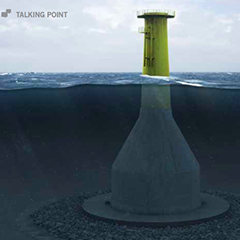Seatower, a Norway-based designer of foundations for offshore wind turbines, is set to become the first to demonstrate gravity-based foundations. We find out more about what could be a game-changing development…
The world’s first self-floating gravity based hybrid foundation will be installed in the English Channel in the fourth quarter of 2014. The Seatower Cranefree Gravity foundation will be deployed at the Fécamp offshore wind farm for Fécamp development partners EDF Energies Nouvelles, Dong Energy and wpd offshore. The three partners have selected Seatower’s game-changing design because of the pioneering technology’s promise to cut construction costs and neutralise installation risks for the offshore wind sector.
The Fécamp demonstrator project is the final step in Seatower’s efforts to move the foundation design to full-scale deployment and industrialisation.
Seatower will manage the installation project, including the demonstration of the entirely new “float-out-and-sink” offshore installation method. This means that, for the first time ever, an offshore wind foundation will be installed using only regular towing vessels. This unique installation method represents the most important aspect of the demonstrator.
The Fécamp demonstration project is scheduled for early 2015. It will showcase the technology’s game-changing installation advantages to developers of offshore wind farms across Europe, especially those with project sites that have deep waters – more than 30 metres – and face the challenging weather conditions that are typical of the North Sea.
Seatower’s technology gives offshore wind farm constructors more overall control of the installation process. Construction management can run foundation installation programmes all year round, uninterrupted by poor weather.
The process can also easily be speeded up if necessary by increasing the number of towing vessels. What’s more, crane-free installation does not involve noisy underwater piling, which is subject to restrictions in several jurisdictions, including “no-build” seasons when installation is prohibited for fear of noise interference with mammals.




























